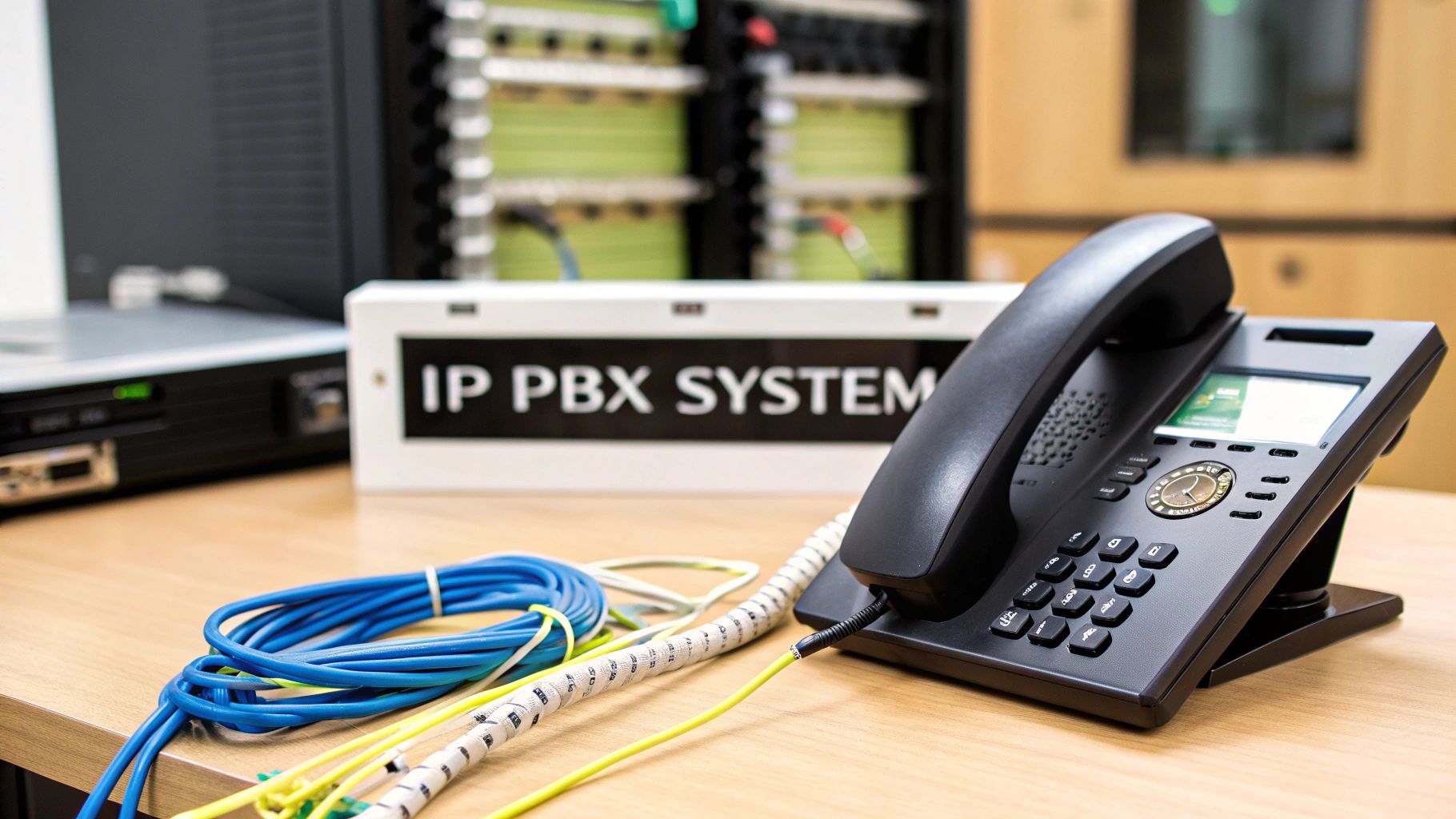Demystifying PBX IP Phone Systems for Modern Businesses
Think of your office communication not just as a phone line, but as a smart traffic controller for all your business conversations. This controller directs every call, video conference, and message using the internet. That’s the core idea behind a PBX IP phone system. It’s a significant upgrade from the old, cabinet-sized switchboards, offering an intelligent platform that changes how businesses connect.
A Private Branch Exchange (PBX) is your organization's own private telephone network. The "IP" simply means it operates over the Internet Protocol. Instead of relying on traditional, often costly phone lines, your conversations are converted into digital data and sent securely over your existing internet connection. This one change from analog to digital unlocks a host of advanced features, turning a simple desk phone into a powerful communication hub. For companies in the UAE and beyond, adopting a modern pbx ip phone system is a practical step toward more efficient operations.
The Two Faces of IP PBX: Hardware vs. Software
When you explore IP PBX options, you'll find two main deployment models. The choice is similar to deciding between buying a physical server to keep in your office versus using a cloud service like Microsoft 365.
- On-Premises IP PBX: This is a hardware-based setup. A physical server, the PBX appliance, is installed and managed at your business location. This gives you direct control over the hardware and your internal network.
- Cloud-Hosted IP PBX: This is a software-based service. A third-party provider hosts and manages the PBX platform, and you access its features over the internet. This approach removes the need for on-site hardware and offers greater flexibility.
To help you picture how these parts work together, the diagram below shows a standard IP PBX architecture.
As the diagram illustrates, all IP phones (physical hard phones on desks and softphones on computers) connect to the central IP PBX through your local network. The PBX then acts as the command center, handling all internal calls and routing external calls through an internet telephony provider to the public telephone network.
This shift in technology is not a minor trend; it's a worldwide movement. The global IP PBX market was valued at approximately USD 32.2 billion in 2025 and is projected to grow to more than USD 87 billion by 2035. This rapid expansion, detailed in a full market forecast, highlights the strong demand for modern communication tools in key industries like finance and healthcare, which are vital to the UAE's economy.
This growth explains why so many companies are moving on from older phone systems. A pbx ip phone system delivers the scalability and rich features needed to compete, allowing even small startups to present a professional, enterprise-level image to their clients.
Inside the Magic: How PBX IP Phone Systems Actually Work
Have you ever wondered what really happens in the moments between dialing a number and hearing someone say "hello"? With a PBX IP phone system, your voice embarks on a high-speed digital journey. It’s a process where your voice is captured, converted into tiny data pieces, and zipped across the internet to be perfectly reassembled on the other end.
Let's follow the path of a single call to see how it all comes together.
The Digital Journey of a Call
The moment you start talking, your IP phone or softphone captures the analog soundwaves of your voice. This is where a component called a codec (short for coder-decoder) steps in. The codec acts as a translator, converting your analog voice into digital information.
This digital data is then broken down into small, numbered bundles called packets. Think of it like sending a large digital photo; your computer splits it into smaller chunks to ensure it sends quickly and reliably. Your voice call gets the same treatment, making its trip across the network efficient and clear.
The Rules of the Road: Key Protocols
For these packets to successfully reach their destination, they must follow a set of rules, or protocols. In the world of IP telephony, two of the most critical protocols are SIP and RTP. You can think of them as the air traffic control and the cargo plane for your call.
- SIP (Session Initiation Protocol): This is the signaling protocol. Like air traffic control, it manages all the logistics of the call. It initiates the connection when you dial, maintains the open line, and terminates the call when you hang up. SIP doesn't carry the sound of your voice; it simply sets up and manages the path. If you want to learn more, you can take a deep dive into what SIP is and how it underpins modern phone systems.
- RTP (Real-time Transport Protocol): This is your cargo plane. Once SIP establishes the connection, RTP takes over to transport the actual voice packets. Its primary job is to ensure the packets are delivered in the correct sequence and with minimal delay, which prevents the audio from sounding jumbled or out of order.
Without SIP, your call would never connect. Without RTP, you would never hear what the other person is saying.
The Central Command: Your PBX Server
All of this digital traffic is directed by the core of the system: the PBX server. This can be a physical server located in your office closet or a virtual one hosted in the cloud, but its function is the same. When you place a call, your request first goes to the PBX server.
The server works like an intelligent switchboard, instantly determining the call's destination. It checks whether the call is internal to another colleague or external to the public phone network, and it verifies user permissions. From there, it routes the call to the right place. This central hub is also responsible for managing key business features like auto-attendants, call queues, and voicemail.
This entire framework is the backbone of modern unified communications. Providers like Cisco build entire platforms on this IP-based foundation, allowing for the integration of calling with messaging, video meetings, and contact center tools.

As the image shows, a PBX IP phone system is far more than a simple replacement for old phone lines; it's a hub for business collaboration. Once the PBX routes the call and the packets arrive, RTP reassembles them in order, and the codec translates them back into clear, audible sound for the listener. Knowing this journey gives you the power to have more productive conversations with vendors and make smarter choices about how your phone system can support your business goals.
Choosing Your Deployment Strategy: On-Premises vs Cloud vs Hybrid
Selecting the right deployment model for your pbx ip phone system is like choosing the right type of office space for your business. Do you buy the building, rent a flexible office, or use a mix of both? Each option—on-premises, cloud, and hybrid—caters to different needs, budgets, and growth plans. The best choice isn’t one-size-fits-all; it’s the one that aligns with your company’s specific operational blueprint.
This decision goes beyond initial cost, shaping your long-term communication power, security posture, and ability to adapt to change.
On-Premises PBX: The Fortress Approach
An on-premises PBX means you own and operate the entire phone system hardware at your physical location. Picture a financial institution or a law firm that requires absolute control over its communication network to protect sensitive client data. This model gives you complete authority over system security and configuration.
However, this level of control comes with trade-offs. It requires a significant upfront capital investment in servers and other hardware. You'll also need a dedicated IT team to manage ongoing maintenance, apply security patches, and handle system updates—costs that can add up over time.
Cloud-Hosted PBX: The Agile Innovator
In stark contrast, a cloud-hosted PBX is managed entirely by a third-party provider, with all services delivered to you over the internet. This setup is perfect for a fast-growing tech startup that needs to add new employees quickly without purchasing and installing more equipment. The key advantages are rapid scalability and a predictable subscription-based cost model (OpEx), which avoids a large initial expense.
This flexibility is a key driver behind the rapid growth of the pbx ip phone system market in the Middle East. Between 2019 and 2024, cloud-based systems saw a major surge in adoption across the UAE, particularly within the expanding SME sector. For businesses considering this route, systems like a Yeastar cloud PBX provide a full suite of modern features. You can find more details in market analysis reports on this trend.
To help clarify these differences, the table below breaks down the three primary deployment models side-by-side.
PBX Deployment Models Comparison
A detailed comparison of on-premises, cloud-hosted, and hybrid PBX deployment options including costs, benefits, and ideal use cases
| Deployment Type | Initial Cost | Maintenance | Scalability | Best For |
|---|---|---|---|---|
| On-Premises | High | Handled by in-house IT staff | Complex and expensive | Businesses needing maximum control and security over their system. |
| Cloud-Hosted | Low to None | Included in subscription; handled by provider | Simple and fast | Growing businesses, SMEs, and companies with remote or mobile teams. |
| Hybrid | Moderate | Shared between in-house team and provider | Flexible; scales based on need | Organizations with mixed needs, like a secure HQ and flexible branch offices. |
As the table shows, the choice often comes down to balancing initial cost and direct control against long-term flexibility and simplified maintenance.
The infographic below offers another visual comparison, contrasting cloud and on-premises deployments across key factors like cost, scalability, and upkeep.

The visual makes it clear: cloud solutions offer a lower barrier to entry and simpler scaling, while on-premises requires a higher initial investment but provides greater hands-on control.
Hybrid PBX: The Best of Both Worlds
For some organizations, neither a pure on-premises nor a pure cloud solution is the perfect fit. This is where a hybrid PBX creates a tailored solution. Consider a retail company with a large corporate headquarters and dozens of smaller branch stores. It might maintain an on-premises system at its main office for centralized security and then connect its retail locations and remote employees using the cloud.
This approach delivers the stability and control of an in-house system where it matters most, combined with the flexibility and cost-efficiency of the cloud for a distributed workforce.
Ultimately, your decision should be based on a clear-eyed assessment of your business. Take stock of your internet reliability, any industry compliance regulations you need to meet, and your company's growth projections. By weighing these factors against the total cost of ownership—which includes maintenance and training—you can select a pbx ip phone system deployment that supports both your current needs and your future goals.
Game-Changing Features That Revolutionize Business Communication
A modern pbx ip phone system is more than just a tool for making and receiving calls; it's the central nervous system for your business communications. These systems come equipped with smart features that change how your team interacts with customers and works together on a daily basis.
What was once the exclusive domain of large corporations is now available to companies of any size. This access allows a small startup to present the same level of professionalism and operational smoothness as a much larger, established company.
Core Call Management Capabilities
The strength of any pbx ip phone system starts with how it handles incoming calls. An Automated Attendant acts as a digital receptionist, welcoming callers with a personalized greeting and a menu of options. This feature guides callers to the correct person or department automatically, ensuring a professional first impression.
This works alongside intelligent call routing, which directs calls based on rules you set, such as team member availability, the time of day, or even the caller's specific needs. Features like voicemail-to-email also make a big difference by transcribing voice messages and delivering them to your email inbox for quick review and organized follow-up.
In competitive markets like the UAE, which is a major hub for the IP PBX industry in the Middle East, businesses depend on these functions. Features like automated attendants and voicemail-to-email are crucial for improving daily operations and keeping customers happy. You can find more details on this market trend to see how local companies benefit.
Enhancing Customer and Team Interaction
Beyond simple call management, these systems directly boost the quality of your customer interactions. Call Queuing is a great example. Instead of hitting a frustrating busy signal, callers are placed into an organized queue, often with hold music or helpful announcements. This small touch reassures them that their call will be answered shortly.
This feature is a staple among the top 10 call center services for its ability to maintain customer satisfaction during peak times. Another major benefit is the ability to connect your phone system with other essential business software, like a Customer Relationship Management (CRM) platform.
When integrated, a customer's entire history can pop up on your agent's screen the moment they call, providing immediate context for a more personal conversation. To make sure these cloud-based tools run smoothly, a strong network is a must. Businesses can look into services from Network as a Service providers to build an infrastructure that can handle modern communication demands.
Key Features and Their Business Impact
Every feature inside a pbx ip phone system plays a role in making your business run more smoothly. Some are straightforward to activate, while others need a bit more setup, but each one is designed to deliver a specific business advantage.
To help you understand the practical value, the table below provides a breakdown of some key features. It outlines what each one does, its benefit to your business, and what to expect in terms of implementation and cost.
PBX IP Phone System Key Features Overview
Comprehensive breakdown of essential PBX features, their business benefits, and implementation considerations
| Feature | Business Benefit | Implementation Complexity | Cost Impact |
|---|---|---|---|
| Call Recording | Useful for team training, quality assurance, and resolving customer disputes. | Low to Moderate | Low to Moderate |
| Analytics & Reporting | Offers clear data on call volumes, wait times, and performance metrics. | Moderate | Moderate |
| Softphone Support | Enables employees to make and take business calls from a computer or mobile device. | Low | Low |
| CRM Integration | Connects call data with customer records for a complete interaction history. | Moderate to High | Moderate to High |
As the table shows, features range from simple additions like softphone support to more involved integrations with a CRM. The key takeaway is that you can select the tools that align with your immediate needs and budget, adding more capabilities as your business grows.
Real Success Stories: Businesses Transformed by PBX IP Systems
While features are great on paper, the true test of a PBX IP phone system is its impact on daily business operations. The results can be remarkable, showing major improvements in efficiency, customer service, and the bottom line. Let's look at how real companies have experienced these benefits firsthand.
Slashing Costs While Boosting Client Satisfaction
Picture a growing consulting firm in Dubai, struggling with outdated phone hardware. Their telecom bills were climbing with every new hire, and the system simply couldn't keep up with their rapid expansion. By switching to a cloud-hosted PBX IP phone system, they saw an immediate financial turnaround.
The firm successfully cut its monthly communication expenses by a staggering 60%. This was possible by getting rid of costly traditional phone line rentals and using internet-based calling instead. Just as importantly, the clear call quality and features like direct-dial numbers for each consultant improved every client conversation, solidifying their professional image and increasing satisfaction.
Empowering a Distributed Sales Force
Another great example is a company with a sales team spread across the UAE. Their old system left remote employees feeling disconnected, which led to missed opportunities and clumsy workflows. Implementing a new IP-based system changed everything.
Using softphone applications on their laptops and mobile devices, the team could finally operate as one cohesive unit. Features like ‘find me/follow me’ automatically sent office calls to their mobile phones, ensuring no sales lead was ever dropped. This seamless mobile integration, paired with better call management tools, led to a measured 40% increase in team productivity.
Building Resilience and Supporting Hybrid Work
Beyond the immediate cost savings and productivity gains, a modern PBX IP phone system delivers a crucial long-term advantage: business continuity. Think of it as a core part of your emergency plan.
If your physical office suddenly becomes inaccessible, a cloud-based system ensures that all communications can be rerouted to mobile devices or remote locations instantly, with zero downtime. The system’s architecture is designed for this kind of flexibility.
As the diagram illustrates, the PBX acts as the central hub, expertly connecting internal IP phones with external lines. This structure guarantees that communication flows smoothly, no matter where your team members are working. It's an ideal setup for supporting flexible hybrid work models.
Maintaining a Professional Edge
Even for smaller businesses, the right phone system can help you project the image of a much larger company. Automated attendants handle initial calls professionally, while call queues manage high volumes so you don't lose potential customers.
To elevate this experience, many PBX IP systems allow for integration with third-party services. For instance, connecting to a dedicated Phone Answering Service ensures that every call is met with a human touch, even after business hours. This simple addition builds customer trust and turns potential missed calls into real opportunities, proving a PBX IP phone system is not just a utility but a powerful tool for growth.
Building Your Integrated Communication Ecosystem
Think of your pbx ip phone system as a busy airport terminal, not a remote landing strip. On its own, it’s functional, but its real power comes from connecting flights—or in this case, other business tools. When you connect it with your other software, you create a powerful communications network.
Imagine this: a customer calls, and their entire order history instantly appears on your agent's screen. Or a missed call automatically becomes a task for your support team. This is the difference between simple phone calls and genuine business intelligence.
From Connectivity to Intelligence: Key Integration Types
For most businesses, the first and most critical connection to make is with a Customer Relationship Management (CRM) platform. When you link your phone system to tools like Salesforce or Zoho, you turn every phone call into an informed conversation.
When a client calls, their entire history—contact details, past orders, and open support tickets—can pop up on the screen before the agent even says hello. This feature, known as a screen pop, gives your team immediate context. Your staff no longer needs to put customers on hold to look up information. They are prepared from the first second, leading to faster resolutions and a much better customer experience.
Another key connection is with the collaboration tools your team uses every day. Integrating your phone system with platforms like Microsoft Teams or Slack tears down the walls between different ways of communicating. For example, weaving your pbx ip phone system directly into Microsoft Teams puts all your communication tools in one place.

As the image shows, calls, chats, files, and meetings can all live within a single application. This means employees aren't constantly switching between windows. A phone call can become a group chat or a video meeting with one click, letting you pull in the right people to solve a problem on the spot. This creates a more fluid workflow that supports quicker decisions and improved teamwork.
Beyond the Obvious: Specialized Integrations
The possibilities don't stop with CRM and chat. You can connect your phone system to specialized software across your entire operation. A great example is linking it to your help desk software.
- A missed call or a new voicemail can automatically generate a support ticket in a platform like Zendesk or Freshdesk.
- This ensures every customer query is logged and assigned without anyone needing to enter data manually.
- The result is a more organized support process where nothing gets lost, leading to faster, more accountable service.
You can also link your pbx ip phone system to your accounting or ERP software. For businesses that bill by the hour, like law firms or consulting agencies, this is a huge efficiency gain. Call logs, including duration and client details, can be sent directly to your billing system. This automates time tracking, improves accuracy, and makes invoicing much faster.
Ultimately, effective integration isn't just about plugging in apps. It requires a clear strategy. Start by mapping out your key business processes and pinpointing where communication slowdowns or information gaps occur. From there, you can choose the integrations that will make the biggest difference. The goal is to build a unified system that empowers your team, making their daily tasks simpler and more impactful.
Your Strategic Implementation Roadmap to Success
Knowing what a **PBX IP phone system** is and successfully installing one are two different things. This process is more than a simple technology purchase; it’s a fundamental shift in how your business communicates. A well-thought-out roadmap is essential to select the right system, manage a smooth transition, and see real results that support your company’s growth.
Foundation First: Assessing Your Business Needs
Before you even think about looking at vendors, the first step is to look inward. This internal review will be the blueprint for every decision that follows. Start by making a list of your current communication frustrations. Are you dealing with poor call quality, expensive phone bills, or a system that can't support your remote team members? Get specific.
Next, look to the future. Do you plan on opening new offices in the UAE or expanding your remote workforce in the next few years? A system that works perfectly for 20 people today could be a bottleneck for 50 users tomorrow. Your assessment must plan for this growth, making sure your new PBX IP phone system is a lasting asset, not a temporary solution. Lastly, take a hard look at your current technical setup, especially your internet connection, which is the very foundation of IP-based calling.
Choosing Your Partner: Vendor Selection Essentials
Once your needs are clearly mapped out, you can start looking for a technology partner. The right provider does more than sell you equipment or a subscription; they become an extension of your team, offering expertise and support. While price is always a consideration, it shouldn't be the only one. A vendor with experience in the AE market will understand the local regulations and carrier details.
When you're meeting with potential partners, ask direct questions to see if they're a good fit:
- What does your standard customer support process look like, and what are your guaranteed response times?
- Can you share case studies or connect us with references from businesses similar to ours in size and industry?
- How do you handle system updates, apply security patches, and perform ongoing maintenance?
- What kind of training do you offer for our everyday users and the system administrators?
The Implementation Plan: From Kickoff to Go-Live
A successful deployment depends on a detailed project plan with achievable deadlines. This plan should cover every stage, from the initial setup and porting your existing numbers to user training and the final switch-over. A major part of this stage is change management. Your team needs to understand not just how to use the new phones, but why the switch is happening and how it makes their jobs easier.
Clear and consistent communication is the best way to get everyone on board and reduce friction. To ensure a great experience from the start, think about how the new system can improve your overall customer communication strategies. A great launch isn't just about the technology working; it's about your team feeling confident and capable with their new tools.
Overcoming Common Hurdles
Even with the most careful planning, you might encounter a few bumps in the road. Thinking about these potential issues ahead of time allows you to have solutions ready.
| Common Challenge | Strategic Solution |
|---|---|
| Staff Resistance to Change | Get key team members involved in the selection process early. Offer comprehensive, hands-on training that focuses on personal benefits for them. |
| Technical Glitches | Run a small pilot program with a test group to find and fix problems before the system is rolled out to the entire company. |
| Budget Overruns | Ask for an itemized quote that covers all possible expenses, including number porting, training sessions, and any necessary hardware. |
By turning your knowledge into a clear action plan, you can steer your organization through this important change with confidence. The objective is to install a phone system that doesn't just work, but actively helps your business grow.
Ready to build a communication ecosystem that scales with your ambition? Cloud Move offers expert consultancy and customized deployments for businesses of all sizes. Request your free demo today and discover how our tailored solutions can optimize your operations and customer engagement.




